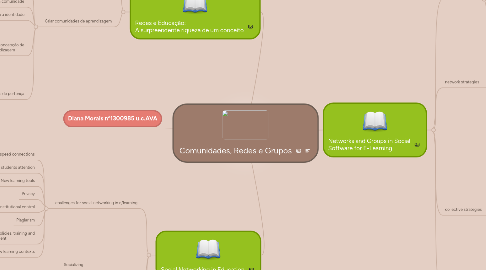
1. Redes e Educação: A surpreendente riqueza de um conceito
1.1. Complementaridade entre conteúdos e contextos
1.2. Criar comunidades de aprendizagem
1.2.1. As componentes de uma teoria de aprendizagem
1.2.1.1. Significado
1.2.1.2. Prática
1.2.1.3. Comunidade
1.2.1.4. Identidade
1.2.2. A relação entre a prática e o significado
1.2.3. A relação entre a prática e a comunidade
1.2.4. A relação entre a prática e a identidade
1.2.5. As dimensões para a concepção de comunidade de aprendizagem
1.2.5.1. Participação/reificação
1.2.5.2. Planeamento/emergência
1.2.5.3. Localidade/globalidade
1.2.5.4. Identificação/negociabilidade
1.2.6. Componentes de pertença
1.2.6.1. Imaginação
1.2.6.2. Alinhamento
1.2.6.3. Empenhamento
2. Social Networking in Education
2.1. challenges for social networking in e/learning
2.1.1. high speed connections
2.1.2. maintaining students attention
2.1.3. New learning tools
2.1.4. Privacy
2.1.5. Individual and institutional control
2.1.6. Plagiarism
2.1.7. Creation of new policies, training and support development
2.1.8. New learning contexts
2.2. Social Networking
2.2.1. Socializing
2.2.2. Sharing
2.2.2.1. fghj
2.2.2.2. fhj
2.2.3. Sojourning
2.3. Using Social Networking Effectively
2.3.1. A learning process more motivating according to the development of new social networking learning designs
2.3.2. Educators have to use and implement new educational applications including OER
2.3.3. Educators have to create ways to promote interaction between learners
3. Diana Morais nº1300985 u.c.AVA
4. Networks and Groups in Social Software for E-Learning
4.1. group strategies
4.1.1. use real time tools
4.1.2. Deploy powerful tool sets such as Moodle
4.1.3. Support standards and tool sets as Open ID
4.1.4. Develop and deploy distributed content management tools
4.2. network strategies
4.2.1. use high quality tools for finding, forming and supporting new and existing networks
4.2.2. develop and deploy tools to support individual control of networks filters
4.2.3. support network deployment on public and intra networks
4.2.4. use tools to support identifying, evaluating and annotating resources
4.2.5. allow members to morph, parcellate and combine networks
4.2.6. use tools or processes that promote trust both of network artefacts and of the people within the network
4.3. collective strategies
4.3.1. increase visibility, compatibility and perceived relative advantage by teachers and users
4.3.2. insure high levels of collective literacy and efficacy
4.3.3. support collective knowledge use in organizational networks and groups
4.3.4. promote contribution to increase individual social capital and institutional brand
4.3.5. support access to collective knowledge outside the organization
4.3.6. support harvesting of collective knowledge
4.3.7. design and development of software
4.3.8. interaction design
4.4. Teaching and learning implications
4.4.1. resume of social software for learning in groups, networks, collectives
